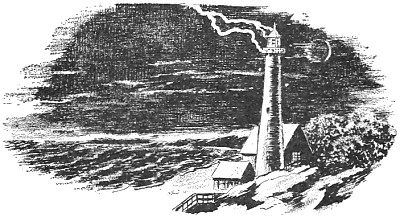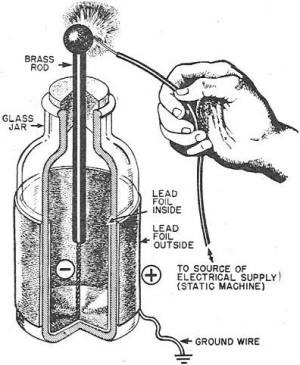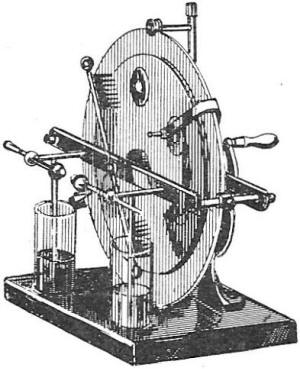|
Electricity - Basic Navy Training Courses NAVPERS 10622 |
|
Here is the "Electricity - Basic Navy Training Courses" (NAVPERS 10622) in its entirety. It should provide one of the Internet's best resources for people seeking a basic electricity course - complete with examples worked out. See copyright. See Table of Contents.
¶ U.S. GOVERNMENT PRINTING OFFICE; 1945 - 618779
CHAPTER 2 Have you ever noticed a girl combing her hair? It seems to dance around as some strands stand away from the rest. You hear a faint crackling sound. If it were dark you would be able to see tiny sparks as the comb moved through her hair. What makes the crackling sound and the sparks? ELECTRICITY - produced by friction, and known as STATIC ELECTRICITY. The key to understanding this frictional electricity is in the action between the girl's hair and the comb. Remember, some strands stood out from each other. These strands had lost some electrons ¬ knocked loose by the friction of the comb against the hair. And the loss of electrons gives the hair a POSITIVE CHARGE.
LIKE CHARGES REPEL EACH OTHER. The positive charges on your girl's hair therefore REPEL each other. That is, they push each other away. That's why her hair stands out after it is combed. You would find that two combs, negatively charged, would REPEL each other. If your girl holds the charged comb close to her charged hair, you'll see that the hair is ATTRACTED to the comb. UNLIKE CHARGES ATTRACT EACH OTHER. These two reactions are a fundamental law of electricity. In short, here is the picture. Friction has dislodged some electrons. This results in the charging of BOTH pieces of matter through the transfer of electrons. One piece is positive, the other is negative. The two unlike charges attract each other but the two like charges repel each other. If the attraction between two unlike charges is strong enough to bring those charges close to each other, the electrons jump back where they belong, DISCHARGING both pieces of matter.- This jumping hack causes the crackling sound you heard and the sparks you saw.
Figure 5. - Charged and uncharged molecules. The transfer of electrons to the hair brings both comb and hair back to normal conditions-that is -every negative electron in the comb or hair is balanced by a positive proton. Figure 5 shows two molecules - a NORMAL or UNCHARGED molecule and a CHARGED molecule. Notice how the charged one is unbalanced-in this case, it has one extra positive charge. This resulted from friction or perhaps only contact, between two unlike substances, causing the REMOVAL OF SOME ELECTRONS from one of the substances and thus unbalancing the charges. The electrons which are knocked out of their molecules cling to anything that's handy. These electrons are called FREE ELECTRONS. The object that picked up the electrons will have a negative charge. RIGHT HERE is a good place to get firmly fixed in your mind the idea that a removal of electrons causes an object to be charged positively and an addition of electrons causes an object to be charged negatively. You are familiar with many cases of static electricity. Remember walking across a heavy rug and then reaching for a door knob or light switch-a spark jumped from your hand? That was static electricity developed by the friction between your shoes and the rug. Lightning is static electricity produced by the friction between air and water particles. A cloud picks up electrons and then discharges them to another cloud or to the earth. WHY ELECTRONS MOVE You are probably wondering why PROTONS were not transferred from hair to comb; why protons aren't scraped off of a rug by shuffling feet. Re-member that protons are much heavier than electrons. About 2,000 times as heavy. Compare a pound of butter to a ton block of granite. Which is most easily moved? This comparison applies to electrons and protons. You will always find that the light electrons will move before the heavy protons will budge. Water in a water tank is like a negative static charge. Given a chance to escape, electrons, like water, will flow from any high level to any lower level. Compare the two diagrams in figure 6. Note that both water and electrons tend to flow from where there is a LOT to where there is a LITTLE.
Figure 6. - Water and electrical potentials. Every charged object has a certain POTENTIAL. And when two charged objects have different potentials, electrons tend to move because of the POTENTIAL DIFFERENCE. In short, POTENTIAL DIFFERENCE CAUSES ELECTRONS TO FLOW. If you compare the charged objects in figure 7, you will notice that the electron flow is always toward the most positive potential. But there is no electron flow when the potentials are equal. Usually charged objects are simply labeled, as in figure 8, with the number of extra negative or extra positive charges.
Figure 7. - Electron flow. The spark from a discharging object is an ELECTRICAL CURRENT. When electrons are held stationary (negative charge) they are STATIC ELECTRICITY; when they move they are CURRENT ELECTRICITY. As you study electricity further, you will find that most usable electricity is moving electricity. Because it is much easier to push electrons through a wire than through air, electricians use wire for moving current. Sparks, which are electric currents in air, are usually accidents.
Figure 8. - Electrical charges and electron flow. CONDENSERS A town may store its water supply in a tank on top of a tower or in a stand-pipe on a hill. This accomplishes two objectives. The water is stored ready for use and by keeping it high above ground it has potential or force to carry it to the consumer. A CONDENSER (often called a CAPACITOR, because it affects capacity) serves the same purpose with electricity. Condensers, or capacitors, are made of alternate layers of metal and non-'metal. These are usually in the ,form of thin strips of foil. A very simple condenser is the Leyden jar. The Leyden jar consists of a glass bottle partially coated with a metal foil-lead or tin. This foil extends about half way up the jar, both inside and outside. A knobbed brass rod runs down through a wood or rubber stopper. It is connected to the inside foil by a dangling metal chain.
The first step in CHARGING a Leyden jar is to GROUND the outside foil. Grounding is merely running a wire from the foil to the ground. This wire furnishes an easy path for the electrons from the foil to the earth. Figure 9 shows a Leyden jar properly grounded and ready for a charge.
Figure 9. - Charging a Leyden jar. Electrons are put on the knob, rod, chain, and inside foil by touching a negatively charged body to the knob. Electrons piling up on the inside foil repel the electrons in the outside foil (like charges repel) , forcing them into the ground. This grounding permits a much higher charge because it allows the electrons on the outside foil to escape. Without the ground wire they would remain on the OUTSIDE foil and repel any attempt to put electrons on the INSIDE foil. As soon as the potential of the inside foil is the same as that of the charging body, electron flow stops. If the knob is connected to an electrostatic generator (see figure 10) a large charge can be concentrated in the jar. This is now a CHARGED condenser. A cloud which is about to let loose a bolt of lightning is a charged condenser - SOME CONDENSER! To DISCHARGE the Leyden jar, connect the knob to either the outside foil or ground by means of a heavily insulated wire. Just as the wire is almost touching the knob, a heavy spark will jump from the knob to the wire. This spark (or arc) is the flow of electrons, which were stored on the inside foil at a high potential. It is quite possible to discharge a condenser through your body by touching both the outside foil and the knob. Thus the current passes through your body. It is likely to be rather SHOCKING. You should remember this whenever you work on a condenser. A condenser discharge is partly responsible for the "hot" spark at a spark plug of a gasoline engine. If you have ever taken this spark through your body, you know that a condenser discharge is no joke.
Figure 10. - Electrostatic generator. Chapter 2 Quiz
|






